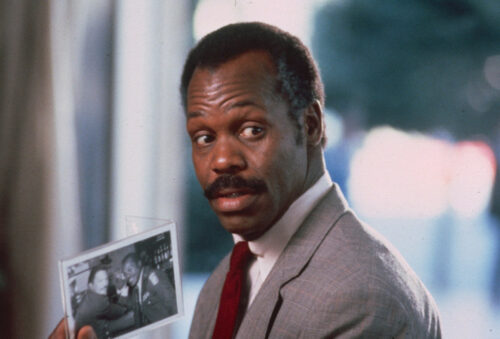Still Film
Date: Thursday December 28 2023
Location: TIFF Bell Lightbox
Still Film
By Brandon Kaufman
Still Film, James N. Kienitz Wilkins’ latest feature-length work, comprises dozens of 35mm publicity stills from movies made between 1981 and 2001. The soundtrack is a fictional deposition in which the players — two lawyers, a witness, and a judge — are all voiced by Wilkins. Rapid volleys of questions, objections, and answers in the voiceover disorientate at first, but as their staccato rhythm coalesces so does the nature of the cross-examination. Wilkins, it seems, is being deposed about his experience as a moviegoer; on trial is nothing less than American industrial filmmaking itself. Precious and presumptuous though the metaphor might be, it is altogether persuasive. Wilkins argues that the shifting historical and aesthetic function of the film still instantiates a larger cultural change.
Since the practice of on-set photography began in the 1910s, stills worked to realise a movie as a commercial entity for potential exhibitors. Stills were portable and so acted as buffers between the idea of a film—its script, a list of its stars—and its reality—its sets, the actors in their gowns. In a 1934 article, the still photographer Donald Mackenzie described how “the salesman who sells the film carries a complete set of stills, which not only tells the story to the exhibitor, but also show him the cast, sets and costumes. In fact, the exhibitor is rarely interested in the film unless he is first impressed by the stills.” In this way, the film continued in newspaper pages or as a pinup on a bedroom wall. Hollywood stardom as we know it was birthed in this dislocation.
In Still Film, Wilkins is interested in how this led to a “compromised shared experience.” The memory of a film becomes moribund as soon as the audience steps from the theatre out into the day. Stills vivified this memory. It is important to note that for the most part, these were not taken as a scene unfolded — they were staged. Actors often had to “do things once more for stills,” which were relit and reframed. Thus accessible memory was not the same as what had been seen. The memory was an ideal, a Magic Mirror turned to the screen.
Cindy Sherman explored the effects of this in her famous series of photographs Untitled Film Stills (1977-1980), in which she posed as various female stock figures from old Hollywood. Sherman’s characters — the hardy femme fatale, the beautiful naif, the oversexed siren — are so generic as to become iconographic. While Sherman’s interest was in cultural depictions of women, she also recognised a broader difficulty in mass imaging. This is the tension present between the anonymity of Sherman’s untitled characters and the uncanny sense of familiarity one feels when encountering them. By cultivating this feeling, Sherman’s pictures enact our “compromised experience”, the way that hazy, artificial images replace specific memory.
Wilkins astutely grounds the testimony of Film Still in his own specific memories. Wilkins is a credible witness: he was born in 1983 along with mass digital photography, and he came of age in the nineties as the New American Independents did. “Half my life lived like a filthy peasant in the 1900s, the other half a decentralised Android wage slave,” he pithily says.
Wilkins speaks of the decentralization of the moving image as its widespread liberation from space and time. Dailies could instantly be reviewed and from the set to studios, and while watching a DVD one could rewind and fast forward as they pleased. Later, day-and-date release vitiated the need to imagine a film at all. Stills thus lost their aura when digital imagery came to prominence. Wilkins is not a celluloid fetishist per se; he instead sees their untethering as part of a larger trend of decentralisation.
Wilkins’ big swing here is to tie this to cryptocurrency, to QAnon’s conspiracies about Tom Hanks, and to the general collapse of a shared epistemic consensus. He invokes the former The Mighty Ducks (1992) star Brooks Pierce who went on to become a crypto billionaire as a kind of Great Man of this sordid history. It is interesting and it is funny, but here the au courant voiceover’s garrulousness begins to overburden the simplicity and rigidity of Wilkins’ images.
More effective are Wilkins digressions on nostalgia, from which he repeatedly distances himself, calling it a “destructive, capitalist brew” that “threatens to alienate the very memories it seeks to preserve”. Still Film invites comparisons to Hollis Frampton’s similarly structuralist (nostalgia) (1971), and their formal differences are particularly generative.
Unlike in Frampton’s exploration of images and memory, though, Wilkins can not burn his pictures. Instead, he simply transitions from one to another, occasionally shuffling back. Where 35mm transparencies as “easy to reproduce, [have] pretty high fidelity, [are] not very archival, fade over time,” Wilkins implies that digital images, including the ones he has scanned, exist with full integrity in a state of purgatory. Mercy eludes the digital image. Wilkins concludes that we, too, are “endless sufferers, stuck on repeat.”
Still Film is all quite dramatic — its condemnations decisive, the breadth of its conclusions outpacing the limited scope of its topic. I suppose, though, it is all quite fitting for the trial of the century.
